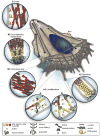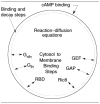Eukaryotic Cell Dynamics from Crawlers to Swimmers
- PMID: 30854030
- PMCID: PMC6402608
- DOI: 10.1002/wcms.1376
Eukaryotic Cell Dynamics from Crawlers to Swimmers
Abstract
Movement requires force transmission to the environment, and motile cells are robustly, though not elegantly, designed nanomachines that often can cope with a variety of environmental conditions by altering the mode of force transmission used. As with humans, the available modes range from momentary attachment to a substrate when crawling, to shape deformations when swimming, and at the cellular level this involves sensing the mechanical properties of the environment and altering the mode appropriately. While many types of cells can adapt their mode of movement to their microenvironment (ME), our understanding of how they detect, transduce and process information from the ME to determine the optimal mode is still rudimentary. The shape and integrity of a cell is determined by its cytoskeleton (CSK), and thus the shape changes that may be required to move involve controlled remodeling of the CSK. Motion in vivo is often in response to extracellular signals, which requires the ability to detect such signals and transduce them into the shape changes and force generation needed for movement. Thus the nanomachine is complex, and while much is known about individual components involved in movement, an integrated understanding of motility in even simple cells such as bacteria is not at hand. In this review we discuss recent advances in our understanding of cell motility and some of the problems remaining to be solved.
Figures

























Similar articles
-
The Roles of Signaling in Cytoskeletal Changes, Random Movement, Direction-Sensing and Polarization of Eukaryotic Cells.Cells. 2020 Jun 10;9(6):1437. doi: 10.3390/cells9061437. Cells. 2020. PMID: 32531876 Free PMC article. Review.
-
The effects of internal forces and membrane heterogeneity on three-dimensional cell shapes.J Math Biol. 2022 Nov 24;86(1):1. doi: 10.1007/s00285-022-01836-x. J Math Biol. 2022. PMID: 36427179
-
The matrix environmental and cell mechanical properties regulate cell migration and contribute to the invasive phenotype of cancer cells.Rep Prog Phys. 2019 Jun;82(6):064602. doi: 10.1088/1361-6633/ab1628. Epub 2019 Apr 4. Rep Prog Phys. 2019. PMID: 30947151 Review.
-
Of Cell Shapes and Motion: The Physical Basis of Animal Cell Migration.Dev Cell. 2020 Mar 9;52(5):550-562. doi: 10.1016/j.devcel.2020.02.013. Dev Cell. 2020. PMID: 32155438 Review.
-
Modeling crawling cell movement on soft engineered substrates.Soft Matter. 2014 Mar 7;10(9):1365-73. doi: 10.1039/c3sm51597d. Soft Matter. 2014. PMID: 24651116
Cited by
-
The Roles of Signaling in Cytoskeletal Changes, Random Movement, Direction-Sensing and Polarization of Eukaryotic Cells.Cells. 2020 Jun 10;9(6):1437. doi: 10.3390/cells9061437. Cells. 2020. PMID: 32531876 Free PMC article. Review.
-
Aromaticity: Quo Vadis.Chem Sci. 2023 Feb 22;14(21):5569-5576. doi: 10.1039/d2sc04998h. eCollection 2023 May 31. Chem Sci. 2023. PMID: 37265727 Free PMC article. Review.
-
Synergistic Effects of Bortezomib-OV Therapy and Anti-Invasive Strategies in Glioblastoma: A Mathematical Model.Cancers (Basel). 2019 Feb 13;11(2):215. doi: 10.3390/cancers11020215. Cancers (Basel). 2019. PMID: 30781871 Free PMC article.
-
Persistent cell migration emerges from a coupling between protrusion dynamics and polarized trafficking.Elife. 2022 Mar 18;11:e69229. doi: 10.7554/eLife.69229. Elife. 2022. PMID: 35302488 Free PMC article.
-
The hidden aromaticity in borazine.RSC Adv. 2022 Mar 10;12(13):7906-7910. doi: 10.1039/d1ra06457f. eCollection 2022 Mar 8. RSC Adv. 2022. PMID: 35424723 Free PMC article.
References
-
- Nürnberg A, Kitzing T, Grosse R. Nucleating actin for invasion. Nature Reviews Cancer. 2011;11(3):177–187. - PubMed
-
- Haeger A, Wolf K, Zegers MM, Friedl P. Collective cell migration: guidance principles and hierarchies. Trends in cell biology. 2015;25(9):556–566. - PubMed
-
- Boekhorst VT, Preziosi L, Friedl P. Plasticity of cell migration in vivo and in silico. Annual review of cell and developmental biology. 2016;32:491–526. - PubMed
-
- Ridley AJ. Life at the leading edge. Cell. 2011;145(7):1012–1022. - PubMed
Grants and funding
LinkOut - more resources
Full Text Sources
Research Materials
